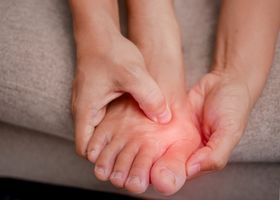Overpronation vs. Underpronation: Similarities and Differences
Updated February 15, 2023

Everyone that walks pronates. Pronation is the normal movement of the foot as we ambulate from place to place and refers to the side-to-side movement of the foot. Sometimes, this normal pattern can be altered, leading to either overpronation or underpronation.
Both overpronation and underpronation place strain on the foot and can lead to significant foot problems if not appropriately managed. In this guide, we explain what these conditions are, the similarities and differences between them, and how to treat over- and underpronation.
What Is Overpronation?
Overpronation refers to the inward turning of the ankles and feet during heel strikes when walking or running. Consequently, the big toe and the second toe push off the ground while the foot twists more with each step. The continuous use of the big toe and second toe for push-off can lead to foot instability. Moreover, the twisting of the foot causes tibial rotation and puts excessive strain on the posterior tibialis tendon, and it may eventually cause shin splints and knee pain.
The causes of overpronation vary. They range from systemic causes to issues associated solely with the ankle and foot complex. Foot overpronation could also be inherited from parents. Regardless of the reason, overpronation develops over a long period. While it may not be a cause of concern initially, without management, it can lead to more debilitating conditions like ligament laxity, rheumatoid arthritis, and shin splints.
Symptoms of overpronation include foot pain, heel pain, unstable ankles, and the development of hammertoes, plantar fasciitis, and Achilles tendinitis.
» Battling overpronation? Check out the best custom insoles and exercises for overpronation
What Is Underpronation?
Also known as excess supination, underpronation causes the outward rolling of the heel and ankles during the heel strike when walking or running. If left unmanaged, underpronation can cause severe pain, injury, and tissue damage in the feet.
Having a high arch, tight tendon, foot or leg injury that alters gait (e.g., hammertoes or fractures), and wearing unsupportive shoes all increase your risk of underpronation. Beyond this, underpronation is caused by plantar fasciitis, shin pain, metatarsalgia, Achilles tendinopathy, ankle sprains, and ankle fractures.
Symptoms of excess supination include arch pain, calluses or bunions on the pinky toes, impaired stability, and falls.
Overpronation vs. Underpronation: What’s the Difference?
Although both overpronation and underpronation involve the movement of the foot when walking, they differ in terms of the direction of the rolling of the foot. While overpronation refers to the inward roll of the ankle as you take a step, underpronation is the outward roll of the ankle.
How to Determine if You Overpronate or Underpronate
You can easily observe if you overpronate or underpronate. Increased wear and tear on the inner side of the sole of your shoe and calluses on the inner side of the big toe, for example, suggest overpronation. In contrast, with underpronation, the outer edge of the sole of your shoe wears faster, and calluses fall along the edge of the small toe.
Furthermore, you can check for overpronation by dipping your feet in water and standing normally on a sheet of cardboard or paper. If your connecting arch has left a print on the paper, you likely have overpronation. If it is not at all visible, you have underpronation.
A medical professional can also help you identify a case of overpronation or underpronation through observation of the arch when standing or a video gait analysis.
» Can orthotics help to relieve my pronation symptoms? Consider investing in pronation custom orthotics to provide support for your feet during your daily activities
Treatments for Overpronation and Underpronation
Once overpronation and underpronation become symptomatic, immediate treatment is needed. Treatments for supination and fixing overpronated feet and ankles aim to relieve symptoms and prevent complications from setting in. The first line of treatment is conservative and involves any of the following methods:
- Use of NSAIDs Non-steroidal anti-inflammatory drugs help relieve heel pain and any other form of discomfort that may have been caused by the overpronation or underpronation of the foot.
- Use of custom orthotics Orthotics for overpronation or underpronation are designed to fit the exact shape of your foot. Upstep orthotics, for example, are designed by certified podiatrists to address your specific foot condition. The custom orthotic provides the support, cushioning, and flexibility required to reduce the strain on the foot and prevent flattening of the arch.
- Proper footwear The best footwear for those with either underpronation or overpronation should have a firm heel counter and a wide support base. As to the midsole density, a firmer midsole is helpful for overpronation, while softer midsoles are better for those that underpronate.
- Physiotherapy Using a combination of electrotherapy, gait re-education, stretches for supination, and exercises for overpronation, a physiotherapist will work with you to relieve any pain and improve your control over your foot movement.
If these fail, invasive treatment is required as a final option. In these instances, surgery will be done to relieve symptoms and prevent complications.








